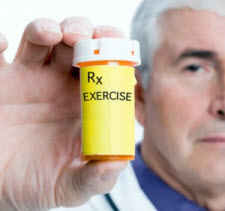The last time you went to see your doctor, did he or she tell you to be more active? To lose some weight? Eat better and exercise?
The majority of Americans with access to healthcare probably heard this from their family doctor. Less than half of all Americans (48 percent) meet suggested guidelines for being active set last decade by the Centers for Disease Control (2008 Physical Activity Guidelines). For adults 18-65, that could be 150 minutes of brisk walking every week, along with a couple of days of doing a handful of push-ups, sit-ups, squats and other muscle-strengthening exercises.
So it makes sense for your family doctor to encourage you to get out and do more. Just telling you go “go exercise,” however, is not the same as having an effective strategy for promoting physical activity.
The American Heart Association just published a “Science Advisory” paper authored by a panel of experts including several noted MDs and Ph.D.s. The advisory calls attention to the National Physical Activity Plan (NPAP), a comprehensive effort to involve governmental and non-governmental entities, and for-profit and non-profit groups at the local, state and national levels to work together to increase physical activity levels in all segments of the population.
The importance of these efforts cannot be understated. Research shows that physical inactivity is associated with increased risk of 25 chronic diseases. The risk of getting coronary artery disease or stroke jumps by 45 percent to 60 percent, respectively. Some 334,000 deaths every year in the United States are caused, at least in part, by an inactive lifestyle, according to the AHA Science Advisory.
Getting primary care physicians and appropriate specialists involved in the effort is critical to success. Growing evidence suggests that behavioral health counseling, as it’s referred to among healthcare professionals, can have a significant impact on a patient’s lifestyle choices in nutrition and exercise.
The key is to provide physicians with the tools and guidelines to effectively counsel patients. The Exercise is Medicine (EIM) initiative (www.exerciseismedicine.org) is one example of a program that is trying to do just that. Launched by both the American College of Sports Medicine and the American Medical Association in 2007, the EIM is a global initiative calling on providers to review and assess every patient’s physical activity level, with office visits ending with an exercise prescription or referral to a qualified health and fitness professional.
Literally, your doctor could hand you a prescription to take a 2-mile run or walk twice a week, or to go to the gym and see a fitness advisor. The American College of Sports Medicine has added an Exercise is Medicine credential program to provide exercise professionals with certification to further promote the campaign.
This is a potential game changer when it comes to promoting healthy, active lifestyles. We tend to listen to our physicians when it comes to our pharmaceutical prescriptions; now we have to recognize that making exercise as natural a part of our health regimen as taking daily vitamins.
The next step, which is not part of the Exercise is Medicine program, is to assess how home and work environments may hinder that success, and to recommend changes that can remove those obstacles. We’ll examine positive trends in that movement in the next blog.
Dr. Annette “Dr. Z” Zaharoff heads the Non-Surgical Center of Texas, focusing on non-surgical alternatives to relieve pain and repair injuries. A former professional tennis player who competed in the WTC circuit, Dr. Zaharoff remains actively involved with the US Tennis Association. Learn more about her at www.drzmd.com. You can follow her on Facebook at www.Facebook.com/DrZaharoff

